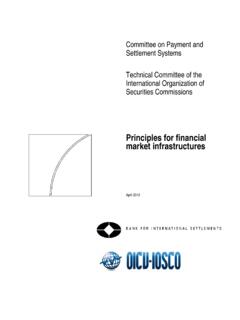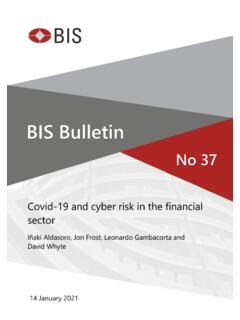Transcription of Guidance on cyber resilience for financial market ...
1 Committee on Payments and market infrastructures Board of the International Organization of Securities Commissions Guidance on cyber resilience for financial market infrastructures June 2016 This publication is available on the BIS website ( ) and the IOSCO website ( ). Bank for International Settlements and International Organization of Securities Commissions 2016. All rights reserved. Brief excerpts may be reproduced or translated provided the source is stated. ISBN 978-92-9197-288-3 (online) CPMI-IOSCO Guidance on cyber resilience for financial market infrastructures June 2016 iii Contents Executive summary .. 1 1. Introduction .. 4 Purpose of the Guidance .. 4 Design and organisation of the Guidance .. 6 Expected usage .. 7 2. Governance .. 9 Preamble .. 9 cyber resilience framework .. 9 Role of the board and senior 10 3. Identification.
2 11 Preamble .. 11 Identification and 11 Interconnections .. 11 4. Protection .. 12 Preamble .. 12 Protection of processes and assets .. 12 Interconnections .. 13 Insider threats .. 13 Training .. 14 5. Detection .. 15 Preamble .. 15 Detecting a cyber attack .. 15 6. Response and recovery .. 16 Preamble .. 16 Incident response, resumption and recovery .. 16 Design elements .. 16 Interconnections .. 17 7. Testing .. 18 Preamble .. 18 Comprehensive testing programme .. 18 Coordination .. 19 iv CPMI-IOSCO Guidance on cyber resilience for financial market infrastructures June 2016 8. Situational awareness .. 20 Preamble .. 20 cyber threat intelligence .. 20 Information-sharing .. 21 9. Learning and evolving .. 22 Preamble .. 22 Ongoing learning .. 22 cyber resilience benchmarking .. 22 Annex A - Glossary .. 23 Annex B Members of the Working Group on cyber resilience (WGCR).
3 27 CPMI-IOSCO Guidance on cyber resilience for financial market infrastructures June 2016 1 Executive summary1 Background. The safe and efficient operation of financial market infrastructures (FMIs) 2 is essential to maintaining and promoting financial stability and economic growth. If not properly managed, FMIs can be sources of financial shocks, such as liquidity dislocations and credit losses, or a major channel through which these shocks are transmitted across domestic and international financial markets. In this context, the level of cyber resilience , which contributes to an FMI s operational resilience , can be a decisive factor in the overall resilience of the financial system and the broader economy. Purpose. The purpose of this document ( Guidance ) is to provide Guidance for FMIs to enhance their cyber resilience . Specifically, this document provides supplemental Guidance to the CPMI-IOSCO Principles for financial market infrastructures (PFMI), primarily in the context of governance (Principle 2), the framework for the comprehensive management of risks (Principle 3), settlement finality (Principle 8), operational risk (Principle 17) and FMI links (Principle 20).
4 This Guidance is not intended to impose additional standards on FMIs beyond those set out in the PFMI, but instead provides supplemental detail related to the preparations and measures that FMIs should undertake to enhance their cyber resilience capabilities with the objective of limiting the escalating risks that cyber threats pose to financial stability. Outline. The Guidance is presented in chapters that outline five primary risk management categories and three overarching components that should be addressed across an FMI s cyber resilience framework. The risk management categories are: governance; identification; protection; detection; and response and recovery. The overarching components are: testing; situational awareness; and learning and evolving. In order to achieve resilience objectives, investments across these Guidance categories can be mutually reinforcing and should be considered jointly.
5 Broad relevance. While the Guidance is directly aimed at FMIs, it is important for FMIs to take on an active role in outreach to their participants and other relevant stakeholders to promote understanding and support of resilience objectives and their implementation. Given the extensive interconnections in the financial system, the cyber resilience of an FMI is in part dependent on that of interconnected FMIs, of service providers and of the participants. Collaboration. Effective solutions may necessitate collaboration between FMIs and their stakeholders as they seek to strengthen their own cyber resilience . Efforts to coordinate the design of resilience solutions may bring enhanced strategies forward in a more timely and efficient way. The outcome of such collaboration should be considered in their individual and collective strategic planning. Because the cyber resilience of FMIs supports broader financial stability objectives and in light of significant interdependencies in clearing and settlement processes, it is important for authorities to cooperate, recognising that such cooperation may help authorities consider, where appropriate, consistency of direction in their oversight and supervision of both FMIs and their relevant stakeholders.
6 Moreover, authorities and FMIs may need to call upon technology companies and other firms to help identify and develop efficient and effective solutions. Governance. Consistent with effective management of other forms of risk faced by an FMI, sound governance is key. cyber governance refers to the arrangements an FMI has put in place to establish, implement and review its approach to managing cyber risks. Effective governance should start with a clear and comprehensive cyber resilience framework that accords a high priority to the safety and efficiency of the FMI s operations while supporting broader financial stability objectives. The framework should be guided by a cyber resilience strategy, define how the FMI s cyber resilience objectives are determined and 1 Technical terms are explained in the glossary in the Annex A. 2 Consistent with the definition in the PFMI, the term FMI refers to systemically important payment systems, central securities depositories (CSDs), securities settlement systems (SSSs), central counterparties (CCPs) and trade repositories (TRs).
7 Relevant authorities, however, may decide to apply this Guidance to types of infrastructure not formally covered by this report. 2 CPMI-IOSCO Guidance on cyber resilience for financial market infrastructures June 2016 outline its people, processes and technology requirements for managing cyber risks. This framework should include timely communication to enable effective collaboration with relevant stakeholders. It is essential that the framework is supported by clearly defined roles and responsibilities of the FMI s board (or equivalent) and its management, and it is incumbent upon its board and management to create a culture which recognises that staff at all levels, as well as interconnected service providers, have important responsibilities in ensuring the FMI s cyber resilience . The chapter on governance includes Guidance on the basic elements of an FMI s cyber resilience framework and how an FMI s governance arrangements should support that framework.
8 Identification. Given that FMIs operational failure can negatively impact financial stability, it is important that FMIs identify their critical business functions and supporting information assets that should be protected, in order of priority, against compromise. The chapter on identification outlines how an FMI should identify and classify business processes, information assets, system access and external dependencies. This helps the FMI to better understand its internal situation, the cyber risks that it bears from and poses to entities in its ecosystem, and how it can coordinate with relevant stakeholders when designing and implementing its cyber resilience efforts. Protection. cyber resilience depends on effective security controls that protect the confidentiality, integrity and availability of its assets and services. The chapter on protection urges FMIs to implement appropriate and effective controls and design systems and processes in line with leading cyber resilience and information security practices to prevent, limit and contain the impact of a potential cyber incident.
9 Detection. An FMI s ability to detect the occurrence of anomalies and events indicating a potential cyber incident is essential to strong cyber resilience . Early detection provides an FMI with useful lead time to mount appropriate countermeasures against a potential breach, and allows proactive containment of actual breaches. Given the stealthy and sophisticated nature of cyber attacks and the multiple entry points through which a compromise could take place, advanced capabilities to extensively monitor for anomalous activities are needed. The chapter on detection outlines monitoring and process tools to be used by an FMI for the detection of cyber incidents. Resumption within two hours (ie two-hour RTO or 2hRTO). financial stability may depend on the ability of an FMI to settle obligations when they are due, at a minimum by the end of the value date. An FMI should design and test its systems and processes to enable the safe resumption of critical operations within two hours of a disruption and to enable itself to complete settlement by the end of the day of the disruption, even in the case of extreme but plausible scenarios.
10 Notwithstanding this capability to resume critical operations within two hours, when dealing with a disruption FMIs should exercise judgment in effecting resumption so that risks to itself or its ecosystem do not thereby escalate, whilst taking into account that completion of settlement by the end of day is crucial. FMIs should also plan for scenarios in which the resumption objective is not achieved. Although authorities recognise the challenges that FMIs face in achieving cyber resilience objectives, it is also recognised that current and emerging practices and technologies may serve as viable options to attain those Furthermore, the rationale for establishing this resumption objective stands irrespective of the challenge to achieve it. The chapter on response and recovery provides Guidance on how an FMI should respond in order to contain, resume and recover from successful cyber attacks.













